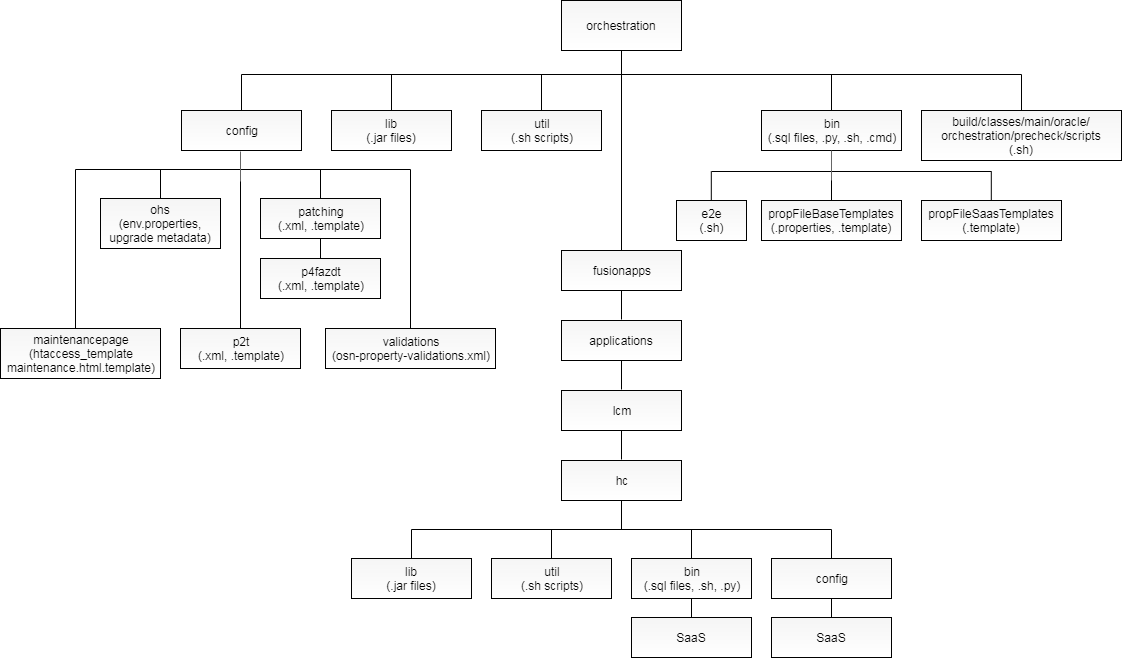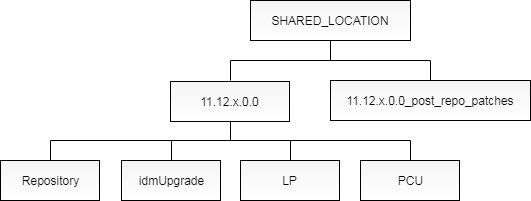1 Introduction to the Oracle Fusion Applications Upgrade
1.1 Upgrade Paths to Release 12
The following upgrade paths are supported for Release 12:
-
Release 8 (11.1.8.0.0) to Release 12 (11.12.x.0.0)
Note that this is a direct upgrade path, with no requirement to upgrade to Release 9, Release 10, or Release 11 during the upgrade process.
Solaris platform supports direct upgrade from Release 8 (11.1.8.0.0) to Release 12 (11.12.x.0.0)
-
Release 9 (11.1.9.x.0) to Release 12 (11.12.x.0.0)
Note that this is a direct upgrade path, with no requirement to upgrade to Release 10 or Release 11 during the upgrade process.
-
Release 10 (11.1.10.x.0) to Release 12 (11.12.x.0.0)
Note that this is a direct upgrade path, with no requirement to upgrade to Release 11 during the upgrade process.
-
Release 11 (11.1.11.x.0) to Release 12 (11.12.x.0.0)
1.2 High Level Checklist to Perform the Upgrade
The following checklist provides the list of tasks necessary to perform the upgrade to Release 12 (11.12.x.0.0):
Table 1-1 Checklist of Upgrade Tasks
| Task Name | Task Description | Reference Link |
|---|---|---|
|
Preliminary steps for the Upgrade |
Information about the resources you must have access to before starting the upgrade |
|
|
System Requirements |
System requirements that must be met for the system to be upgraded |
|
|
Create Directories and Stage the Software |
Details about the directories that must be created and the software and patches that must be downloaded and staged before starting the upgrade |
|
|
Set Up Upgrade Orchestrator |
Steps to set up the orchestration software, followed by additional preparation steps for the upgrade |
|
|
Verify Environment Before Proceeding With Downtime |
Steps to verify your environment before starting the upgrade |
|
|
Update Oracle Fusion Applications and Oracle Identity Management Databases |
Steps to update the databases |
Update the Oracle Fusion Applications and Oracle Identity Management Databases |
|
Run steps to ensure system reliability |
Steps to run checks to ensure system reliability |
|
|
Run Pre-upgrade Steps During Downtime |
Steps that must be run if upgrading from Release 8 or Release 9 |
|
|
Update the Database and Middle Tier Credential Stores |
Pre-upgrade steps that must be performed Before running RUP Installer |
|
|
Run Upgrade Orchestrator During Downtime |
Steps to run Upgrade Orchestrator to perform the upgrade |
|
|
Pause Point 1 - Run RUP Lite for OVM in Pre-Root Mode (Oracle VM Only) |
Steps to run RUP Lite for OVM in pre-root mode. This pause point applies only to Oracle VM environments |
Pause Point 1 - Run RUP Lite for OVM in Pre-Root Mode (Oracle VM Only) |
|
Pause Point 2 - Upgrade Oracle Identity Management to Release 12 |
Steps to upgrade Oracle Identity Management, followed by steps to update the status of the pause point task to proceed with the upgrade. |
Pause Point 2- Upgrade Oracle Identity Management to Release 12 |
|
Pause Point 3 - Reload Orchestration |
Steps to reload orchestration, followed by steps to update the status of the pause point task to proceed with the upgrade |
|
|
Pause Point 4 - Run RUP Lite for OVM in Post-Root Mode (Oracle VM Only) |
Steps to run RUP Lite for OVM in post-root mode. This pause point applies only to Oracle VM environments |
Pause Point 4- Run RUP Lite for OVM in Post-Root Mode (Oracle VM Only) |
|
Pause Point 5 - Create the Incremental Provisioning Response File |
Steps to create the response file if incremental provisioning is run |
Pause Point 5 - Create the Incremental Provisioning Response File |
|
Pause Point 6 - Perform Incremental Provisioning |
Steps to run incremental provisioning |
|
|
Run Upgrade Orchestrator in the Downtime During Language Pack (LP) phase |
Steps to run orchestration to perform LP upgrade tasks |
|
|
Run Post Upgrade Tasks |
Required post upgrade tasks that must be performed after Upgrade Orchestrator runs to successful completion |
|
|
Troubleshoot the Upgrade |
Possible failure and error scenarios that may occur during the upgrade, including solutions or workarounds |
1.3 Hosts, Directories, and Files Required by Upgrade Orchestrator
Before proceeding with the upgrade, get familiar with the following concepts and information:
1.3.1 Host Types
The Release 12 upgrade must be performed on the following host types:
-
Primordial host: The location of the Common domain, specifically the Administration Server of the Common domain. Only one primordial host exists in each environment.
-
IDM host: A combination of hosts which hosts OID, OIM, OAM, IDM OHS, and IDM Database services. OIF is optional.
-
OHS host: The host where the Oracle HTTP Server (OHS) software is installed and configured.
-
DB host: The host where the Oracle Fusion Applications database is installed and configured.
-
Midtier hosts: Includes the following hosts:
-
Primary host: The host on which the Administration Server of a domain runs. Only one primary host exists in a domain.
-
Secondary host: The location of the managed servers for any application when they are not on the same host as the administration server of the same domain. Typically used when a domain spans two physical servers.
-
BI host: The host where the Oracle Business Intelligence (Oracle BI) software is installed and configured.
-
Note that all of these host types can be scaled out to multiple hosts, and Upgrade Orchestrator must be run on each scaled out host for all host types, with the exception of DB hosts. See Scale Oracle Fusion Applications in the Oracle Fusion Applications Installation Guide.
1.3.2 Directories and Files Required by Upgrade Orchestrator
The following directories and files are referenced in this guide and are required by Upgrade Orchestrator:
-
SHARED_LOCATION: This directory is created in a shared location, which is accessible to all hosts in the environment, including scaled out hosts. See Create Directories in a Shared Location.
-
ORCHESTRATION_CHECKPOINT_LOCATION and ORCHESTRATION_CHECKPOINT_ARCHIVE_LOCATION: These directories are created under SHARED_LOCATION, where orchestration checkpoint related files are saved. See Create Orchestration Checkpoint Locations. These directory locations are stored as properties in the
pod.propertiesfile. See Table 11-1. -
SHARED_UPGRADE_LOCATION: This temporary directory is created to copy files and perform write operations. See Create the Shared Upgrade Location Directory.
-
ORCH_LOCATION: This directory is created when unzipping
orchestration.zipand is referred to as the orchestration directory. See Unzip Orchestration.zip. -
POD_NAME: This is the name used throughout this guide to refer to the directory created. It is possible to create the
POD_NAMEdirectory under ORCH_LOCATION. -
Manifest files: Manifest files are .xml type distribution files that are required by both Upgrade Orchestrator and Health Checker. These files are used throughout this guide to define specific tasks performed during the upgrade process.
1.4 Back Up Strategy
Before starting the upgrade process, knowledge of the backup requirements is needed, as there are multiple components involved in an Oracle Fusion Applications environment. An effective and accurate backup strategy helps to restore from the point of failure without having to restart from the beginning. Backups are manual steps and can be automated outside of Upgrade Orchestrator based on the IT requirements and processes.
The following components must be backed up:
-
Oracle Fusion Applications, including the following:
-
Oracle Fusion Applications database
-
APPLICATIONS_BASEdirectory -
APPLICATIONS_CONFIGdirectory -
Oracle Identity Management database
-
Upgrade Orchestration directories
-
OHS and /etc/hosts files
-
Central Inventory
-
-
OPSS Security Store: This component is backed up by Upgrade Orchestrator.
Note:
Back up the Oracle Fusion Applications upgrade at multiple stages during the upgrade process. It is recommended to back up the entire Fusion Applications environment, including the databases before and after the upgrade.1.5 Plan the Downtime
Consider the following suggestions when planning the downtime for the upgrade:
-
Perform pre-downtime steps ahead of time. See Prepare for the Release 12 Upgrade Before Downtime.
-
Perform the database patching in a separate maintenance window. See Update the Oracle Fusion Applications and Oracle Identity Management Databases.
-
Perform steps to check system reliability in pre-downtime mode after all prerequisites are met. See Run Pre-Downtime Checks.
1.6 Directories Structure Overview
Upgrade Orchestrator references and uses the following directories:
1.6.1 The ORCH_LOCATION Directory
The following figure shows the directory structure that is created when the Orchestration.zip file is unzipped, and is referred to as ORCH_LOCATION. See Unzip Orchestration.zip.
Figure 1-1 Directory Structure of Upgrade Orchestrator

1.6.2 Download Directories
The following figure shows the directory structure that is created during the preparation of the environment for the upgrade. There are specific files that must be downloaded into each of these directories. See Create Directories in a Shared Location.
Figure 1-2 Directory Structure of Downloaded Patches and Repositories

1.6.3 Oracle Fusion Applications Shared Directories
The following home directories are referenced during the upgrade steps:
-
APPLICATIONS_CONFIG
The root directory for the Oracle Fusion Applications configuration and instance files.
-
APPLICATIONS_BASE
The root directory for the Oracle Fusion Applications product binary files.
-
FA_ORACLE_HOME
The Oracle Fusion Applications Oracle home directory. This directory is located under the
APPLICATIONS_BASE/fusionappsdirectory (net/mount1/appbase/fusionapps). The/fusionappsdirectory is an Oracle Fusion Applications Middleware home (APPLICATIONS_BASE/fusionapps).
See Oracle Fusion Applications Shared Directory Structure in the Oracle Fusion Applications Installation Guide.
1.7 Incremental Provisioning
Incremental provisioning provides the ability to extend the Oracle Fusion Applications environments during the upgrade. This extension is done by adding product offerings that are introduced in a release that is higher than the release of the existing Oracle Fusion Applications environments. A product offering is a logical grouping of features and functionality of Oracle Fusion Applications.
To use incremental provisioning, the Provisioning Wizard from a prior release must have been used to create the environment. See Extend an Oracle Fusion Applications Environment Using Incremental Provisioning During Upgrade in the Oracle Fusion Applications Installation Guide. Alternatively, use incremental provisioning if the Oracle Fusion Applications environment is created from Oracle Fusion Applications Oracle Virtual Machine (VM) templates. See Deployment of Oracle VM Templates in the Oracle Fusion Applications Installing and Managing in an Oracle VM Environment.
Adding optional VM hosts for product offerings such as, Value Chain Planning (VCP) and Governance, Risk and Control (GRC) during upgrade for environments previously created from a prior release of Oracle Fusion Applications Oracle Virtual Machine (VM) templates is not supported.